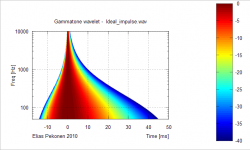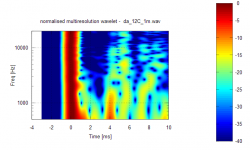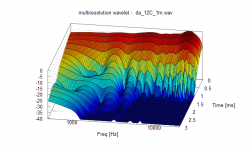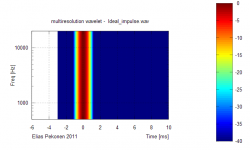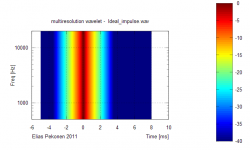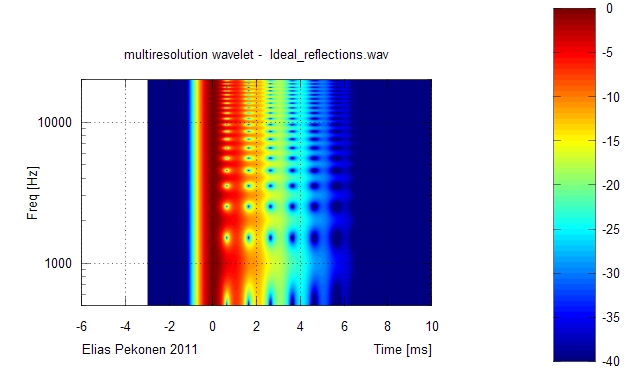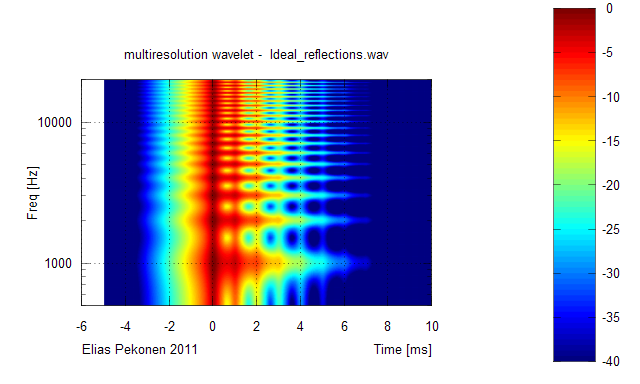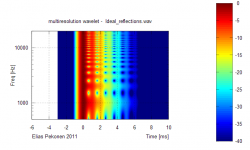Hello,
Can you show the dB scale as well?
- Elias
Can you show the dB scale as well?
- Elias
Elias,
what do you think about the picture of your ideal reflection work horse made by STransform?
An externally hosted image should be here but it was not working when we last tested it.
The axes are arranged like in your examples.
Best regards and a Happy New Year 🙂
Uli
I can see the basic shape but the details are hdden under the 8dB grid, a bit coarse for me. Is it possible to limit the plot dynamic range to something like 40dB?
-Elias
-Elias
Seems your S transform is about the same as my constant Q wavelet but with little bit higher Q than in my plot (freq resolution preference):
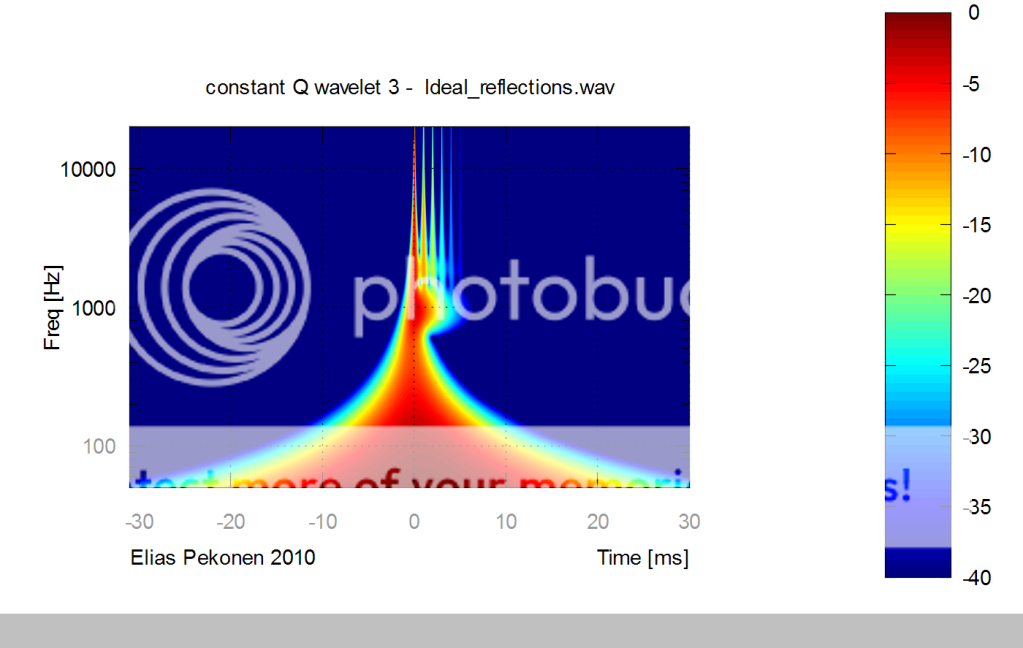
- Elias

- Elias
However, nowadays I think constant Q is not optimal for human audio, but I prefer Bark wavelet or better yet Gammatone wavelet for improved perception modelling.
- Elias
- Elias
Dr Geddes reported that he couldn't get this to work under Win 7. I'm using Windows 2008 x64, and I had problems too. Here's how I got it to work:
Hope this helps the folks who aren't running linux.
- Don't use the Le'Cleach wavelet analysis - it doesn't work. There's a function names gausplus2 which doesn't seem to exist. I believe this is noted in this thread, but it took some digging for me to realize that.
- The command line version of Gnuplot doesn't seem to work under x64 Windows. If you run the script from Xoctave, it seems to use the wGnuplot, which *does* work.
Hope this helps the folks who aren't running linux.
Don't use the Le'Cleach wavelet analysis - it doesn't work. There's a function names gausplus2 which doesn't seem to exist. Hope this helps the folks who aren't running linux.
Hello,
Eventually, give a look to this
Gauspuls written for Octave:
octave-signal 1.0.7, gauspuls_8m-source.html
IMHO Matlab's Gauspuls is "a no brainer" and at the expense of a longer run time it can be written with conventional functions.
(And in the case of the search for a very short runtilme one can eventually used the quasi gaussian pulse window I used in Hornresp's wavelets tranform module)
Best regards from Paris, France
Jean-Michel Le Cléac'h
Hello
I have to add to my last message that, as noted by Michael, in hiq message:
http://www.diyaudio.com/forums/mult...udio-measurements-what-how-2.html#post2135917
Octave's Gauspuls function only return the "in phase" component (cos) and lacks the "in quadrature" component (sin).
In Matlab both the "in phase" component (cos) and the "in quadrature" component (sin) are returned in a line like this:
[yi,yq] = gauspuls(...) yi the in-phase pukse and yq the quadrature pulse.
The octave code for Gauspuls only calculate the in phase y part, see the line:
y = exp(-t.*t/(2.*tv)).*cos(2.*pi.*fc.*t);
I guess the "in quadrature" z component can be calculated just adding a line as:
z = exp(-t.*t/(2.*tv)).*sin(2.*pi.*fc.*t);
Best regards from Paris, France
Jean-Michel Le Cléac'h
I have to add to my last message that, as noted by Michael, in hiq message:
http://www.diyaudio.com/forums/mult...udio-measurements-what-how-2.html#post2135917
Octave's Gauspuls function only return the "in phase" component (cos) and lacks the "in quadrature" component (sin).
In Matlab both the "in phase" component (cos) and the "in quadrature" component (sin) are returned in a line like this:
[yi,yq] = gauspuls(...) yi the in-phase pukse and yq the quadrature pulse.
The octave code for Gauspuls only calculate the in phase y part, see the line:
y = exp(-t.*t/(2.*tv)).*cos(2.*pi.*fc.*t);
I guess the "in quadrature" z component can be calculated just adding a line as:
z = exp(-t.*t/(2.*tv)).*sin(2.*pi.*fc.*t);
Best regards from Paris, France
Jean-Michel Le Cléac'h
Hello
Matlab's code for the gauspuls function:
http://www.kemt.fei.tuke.sk/predmety/KEMT515_MT/_materialy/signal/signal/gauspuls.m
Best regatds from Paris, France
Jean-Michel Le Cléac'h
Matlab's code for the gauspuls function:
http://www.kemt.fei.tuke.sk/predmety/KEMT515_MT/_materialy/signal/signal/gauspuls.m
Best regatds from Paris, France
Jean-Michel Le Cléac'h
Hi,
Gammatone wavelet on ideal impulse.
Notice the temporal asymmetry.
- Elias
Gammatone wavelet on ideal impulse.
Notice the temporal asymmetry.
- Elias
I looked through some Gammatone information, it certainly looks interesting.
Attachments
Hi,
I've tested Octave 3.0.3 in Windows 7 and did not encounter any problems.
For the Gnuplot, there is no need to run it from the command line if you are willing to run Octave as it plots pictures as you define in the script.
- Elias
I've tested Octave 3.0.3 in Windows 7 and did not encounter any problems.
For the Gnuplot, there is no need to run it from the command line if you are willing to run Octave as it plots pictures as you define in the script.
- Elias
Dr Geddes reported that he couldn't get this to work under Win 7. I'm using Windows 2008 x64, and I had problems too. Here's how I got it to work:
- Don't use the Le'Cleach wavelet analysis - it doesn't work. There's a function names gausplus2 which doesn't seem to exist. I believe this is noted in this thread, but it took some digging for me to realize that.
- The command line version of Gnuplot doesn't seem to work under x64 Windows. If you run the script from Xoctave, it seems to use the wGnuplot, which *does* work.
Hope this helps the folks who aren't running linux.
Hello
Despite the unfair words he used I took Patrick Bateman's words as a request for help.
So on the week-end I modified my Matlab routine in order to not use the "gauspuls" function.
You'll find in attached file the new routine
The gaussian enveloppe wavelet pulse is calculated from line 98 to 102
(a ratio bandwith/center frequency of .7 is used).
I think this routine will be easily translated in Scilab or in Octave.
The default parameters for the analysis are set to analyse the pulse response of a horn, a medium loudspeaker or a tweeter. You can adapt the parameters to your need on lines 45 to 49.
For bass loudspeakers a minimum frequency ( fmin ) value of 20 (Hz) may be used but in that case the time limit ( tmax ) of the signal window should be increased (e.g. : tmax = 0.025 ). Please notice that tmax is expressed in seconds not in miliseconds.
Best regards from Paris, France
Jean-Michel Le Cléac'h
Don't use the Le'Cleach wavelet analysis - it doesn't work. There's a function names gausplus2 which doesn't seem to exist.
Despite the unfair words he used I took Patrick Bateman's words as a request for help.
So on the week-end I modified my Matlab routine in order to not use the "gauspuls" function.
You'll find in attached file the new routine
The gaussian enveloppe wavelet pulse is calculated from line 98 to 102
(a ratio bandwith/center frequency of .7 is used).
I think this routine will be easily translated in Scilab or in Octave.
The default parameters for the analysis are set to analyse the pulse response of a horn, a medium loudspeaker or a tweeter. You can adapt the parameters to your need on lines 45 to 49.
For bass loudspeakers a minimum frequency ( fmin ) value of 20 (Hz) may be used but in that case the time limit ( tmax ) of the signal window should be increased (e.g. : tmax = 0.025 ). Please notice that tmax is expressed in seconds not in miliseconds.
Best regards from Paris, France
Jean-Michel Le Cléac'h
Attachments
Last edited:
Hello,
Gammatone. For modelling the response of basilar membrane.
My idea is to generate wavelet from gammatone and use it to analyse impulse responses.
Characteristic of the gammatone filter
http://www.pdn.cam.ac.uk/groups/cnbh/research/publications/pdfs/SVOS%20Annex%20C%201988.pdf
http://cobweb.ecn.purdue.edu/~malcolm/apple/tr35/PattersonsEar.pdf
- Elias
Gammatone. For modelling the response of basilar membrane.
My idea is to generate wavelet from gammatone and use it to analyse impulse responses.
Characteristic of the gammatone filter
http://www.pdn.cam.ac.uk/groups/cnbh/research/publications/pdfs/SVOS%20Annex%20C%201988.pdf
http://cobweb.ecn.purdue.edu/~malcolm/apple/tr35/PattersonsEar.pdf
- Elias
Hello,
Here's the updated Octave script to calculate multiresolution wavelet from the impulse response file.
It plots wavelet and normalised wavelet in spectrogram and 3D format.
http://dl.dropbox.com/u/2400456/html/Elias%20Pekonen/main.html
go to wavelets
I hope to add more scripts for other types of wavelets.
Note that this 3D multiresolution wavelet is equivalent to cumulative spectral display with gaussian window 🙂
Enjoy!
- Elias
Here's the updated Octave script to calculate multiresolution wavelet from the impulse response file.
It plots wavelet and normalised wavelet in spectrogram and 3D format.
http://dl.dropbox.com/u/2400456/html/Elias%20Pekonen/main.html
go to wavelets
I hope to add more scripts for other types of wavelets.
Note that this 3D multiresolution wavelet is equivalent to cumulative spectral display with gaussian window 🙂
Enjoy!
- Elias
Attachments
New version of WTF-Package available
http://www.diyaudio.com/forums/soft...wavelet-analysis-available-2.html#post2492095
Have fun !
Michael
http://www.diyaudio.com/forums/soft...wavelet-analysis-available-2.html#post2492095
Have fun !
Michael
Hello,
I have bad news and good news 😀
Bad news first:
As everyone probably noticed my multiresolution wavelet has been severely lacking! It has been only monodimensional in the resolution space! 😱 🙁 😱 😛

I wonder why nobody informed me about this obvious lack 😕
Then the good news:
I made the required additions to the resolution domain and generated new 'true' multidimensional wavelets 😎
Next I print some examples to highlight the improment. In a TV shop style there will be before-after comparison
- Elias
I have bad news and good news 😀
Bad news first:
As everyone probably noticed my multiresolution wavelet has been severely lacking! It has been only monodimensional in the resolution space! 😱 🙁 😱 😛


I wonder why nobody informed me about this obvious lack 😕
Then the good news:
I made the required additions to the resolution domain and generated new 'true' multidimensional wavelets 😎

Next I print some examples to highlight the improment. In a TV shop style there will be before-after comparison
- Elias
Welcome to the TV shop channel! We have a remedy for all of your problems  Look at this ideal impulse response before and after the new method is applied.
Look at this ideal impulse response before and after the new method is applied.
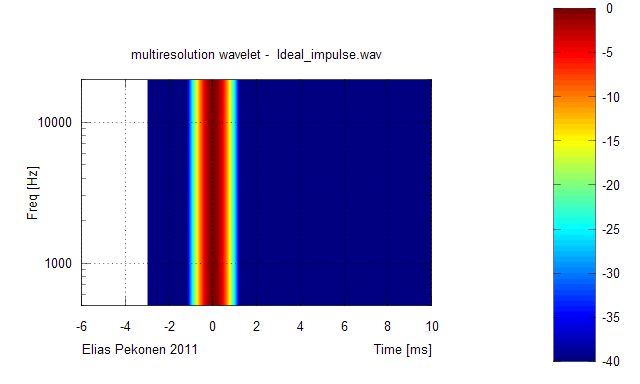

Ok, this is boring lets move on..
- Elias
 Look at this ideal impulse response before and after the new method is applied.
Look at this ideal impulse response before and after the new method is applied.

Ok, this is boring lets move on..
- Elias
Attachments
- Status
- Not open for further replies.
- Home
- Loudspeakers
- Multi-Way
- WTF!? Wavelet TransForm for audio measurements - What-is? and How-to?
